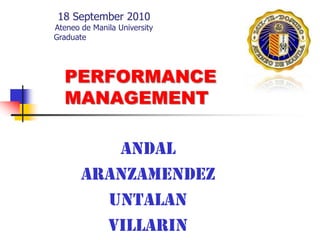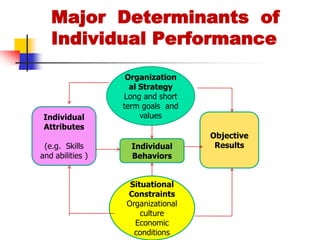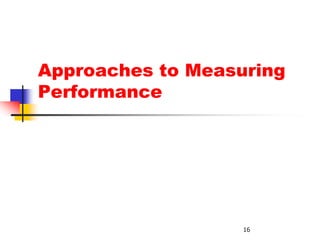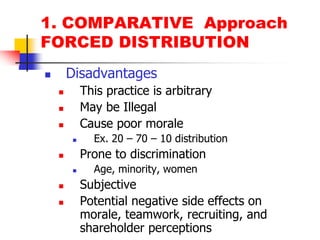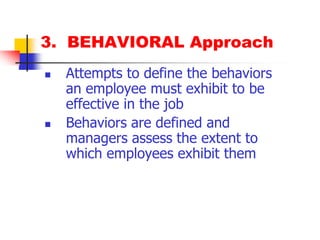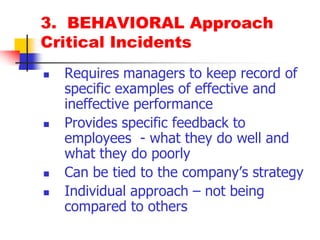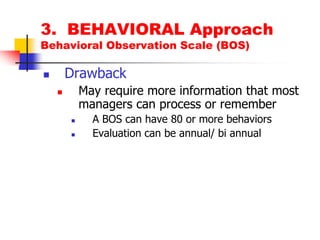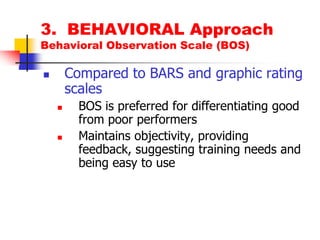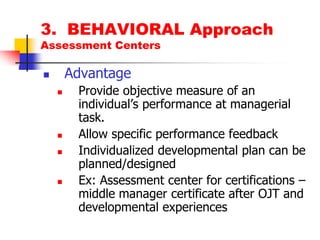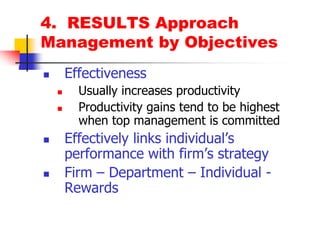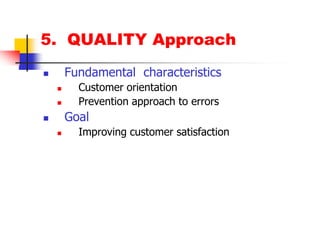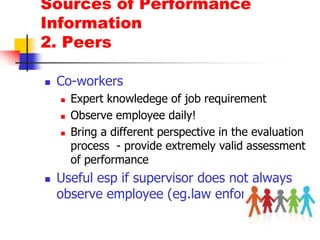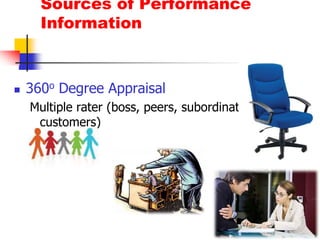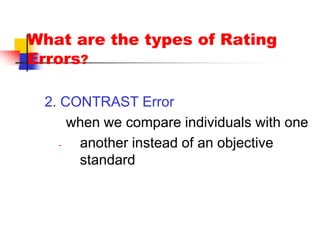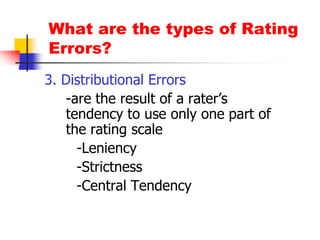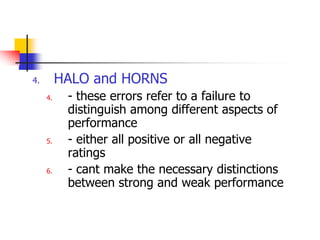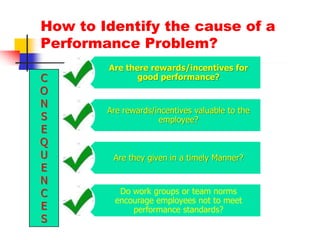Performance management
- 1. 18 September 2010Ateneo de Manila University Graduate School of BusinessMBAH Batch 8PERFORMANCE MANAGEMENTandalaranzamendezuntalanvillarin
- 2. Don RebsAndalRicky AranzamendezTong UntalanDing Villarin
- 3. OBJECTIVESIdentify major determinants of individual performanceDiscuss the three general purposes of performance managementIdentify the five criteria for effective performance management systemDiscuss the four approaches to performance management, specific techniques used in each approach, & the way these approaches compare with criteria for effective performance management system
- 4. OBJECTIVESChoose the most effective approach to performance measurement for a given situationDiscuss the advantages & disadvantages of the different sources of performance informationChoose the most effective source/s for performance information for any situationDistinguish types of errors & explain how to minimize each in a performance evaluationIdentify the cause of a performance problem
- 5. What is Performance Management?Means through which managers ensure that employees’ activities and outputs are congruent with the organization’s goals.
- 6. Parts of Performance Management System1. Job Analysis ( Define ) - specifies which aspect of performance are relevant to the organization 2. Performance Appraisal ( Measure ) - measures aspect of performance, how well an employee is doing his job
- 7. Parts of Performance Management System3. Performance Feedback - provides feedback to employee, tying rewards to performance through compensation system - employees effectiveness
- 8. Major Determinants of Individual Performance Organizational StrategyLong and short term goals and values Individual Attributes (e.g. Skills and abilities )Objective Results Individual Behaviors Situational ConstraintsOrganizational culture Economic conditions
- 9. Purposes of Performance Management1. Strategic Purpose - link employee activities with organization’s goals the results, behavior, employee characteristics developing measurement and feedback mechanism 2. Administrative Purpose - administrative decisions: salary administration, promotions, retentions, layoffs, and recognition
- 10. Purposes of Performance Management3. Developmental Purpose - develop employees who are effective - identifies deficient aspects of employees’ performance and its causes
- 11. Five Criteria for Effective Performance Management 1. Strategic Congruence - extent to which the performance management system elicits job performance that is consistent with the organization’s strategy, goals and culture - guide employees in contributing to the organization’s success 2. Validity - assesses all the relevant and only the relevant aspects of job performance
- 12. Five Criteria for Effective Performance Management “ Content Validity”Job performance measureActual, or “true” job performanceContaminationDeficiencyValidity
- 13. Five Criteria for Effective Performance Management3. Reliability - consistency of a performance measure, free from random error - interrater reliability - internal consistency reliability - test - retest reliability: reliable over time
- 14. Five Criteria for Effective Performance Management 4. Acceptability - satisfactory or adequate by those who use it - 3 categories of perceived fairness: > procedural > interpersonal > outcome fairness5. Specificity - detailed guidance to employees about what is expected and how they can meet these expectation
- 15. Approaches to Measuring PerformanceRebsAndal, MD15
- 16. Approaches to Measuring Performance16
- 17. Approaches to Measuring performanceWe can manage performance by focusing on:Employee attributesBehaviorsResultsAddition:Overall comparisons among individuals’ performanceEmphasis on Quality
- 18. Learning Objective:Approaches to Measuring performanceExplore various approaches to measuring and managing performanceDiscuss techniques associated with each approachEvaluate the approached based on criteriaStrategic congruence, validity, reliability, acceptability and specificity
- 19. 1. COMPARATIVE ApproachRequires the rater to COMPARE an individual’s performance with that of othersUses overall assessment of an individual’s performanceDevelop some RANKING of the individuals within the group
- 20. 1. COMPARATIVE ApproachThree TechniquesRankingForced distributionPaired comparison
- 21. 1. COMPARATIVE ApproachRANKINGSimple rankingRank employees within their department from hishest to poorest performerBEST TO WORSTAlternation RankingList of employees, cross the best and worst employee
- 22. 1. COMPARATIVE ApproachRANKINGCaution!Received attention in the courtsValidation of the selection system using employee rankings as the measure of performanceCriteria of job performance may vary from one supervisor to anotherA focused and stable body of criteria is warranted
- 23. 1. COMPARATIVE ApproachFORCED DISTRIBUTIONAlso uses ranking formatEmployees ranked in groupsEmployees put in predetermined categoriesBest workers, in between, worst workersBottom 10%No bonuses and can be terminated
- 24. 1. COMPARATIVE ApproachFORCED DISTRIBUTIONForces manager to categorize employeesBased on distribution rules not on performanceAdvantageIdentifies high potential employeesIdentifies poorest performersProvides mechanism to help align company performance and employee performance and compensation
- 25. 1. COMPARATIVE ApproachFORCED DISTRIBUTIONSee table 8.4 page 357
- 26. 1. COMPARATIVE ApproachFORCED DISTRIBUTIONDisadvantagesThis practice is arbitraryMay be IllegalCause poor moraleEx. 20 – 70 – 10 distributionProne to discriminationAge, minority, womenSubjectivePotential negative side effects on morale, teamwork, recruiting, and shareholder perceptions
- 27. 1. COMPARATIVE ApproachPAIRED COMPARISONCompare every employee with every other employee1 point for every higher performanceTotal score obtainedTIME CONSUMING
- 28. 1. COMPARATIVE ApproachEVALUATIONEffective in differentiating employee performanceEasy to develop and easy to useCommon failure to be linked to the strategic goal of the organizationSubjective – dependent on ratersLack specificity for feedbackHow can the individual improve his ranking
- 29. 2. ATTRIBUTE ApproachFocuses on extent to which individuals have certain attributesCharacteristic or traitDefine a set of traits for evaluationInitiative, leadership, and competitiveness
- 30. 2. ATTRIBUTE ApproachGraphic Rating ScalesList of traits evaluated by a five point rating scale See table 8.5 p 360
- 31. 2. ATTRIBUTE ApproachGraphic Rating ScalesList of traits evaluated by a five point rating scale Legal defensibility:SubjectiveCriticized appraisals – should demonstrate that rating is objectively related to actual work behavior
- 32. 2. ATTRIBUTE ApproachMixed Standard Scalesimproved versionRelevant performance dimensionsStatements representing good, average and poor performanceSee table 8.6 p360
- 33. 2. ATTRIBUTE ApproachMixed Standard Scalesimproved versionRelevant performance dimensionsStatements representing good, average and poor performanceOriginally developed as trait-oriented scalesInstrument using behavioral statements as a means of reducing rating errors in performance appraisal
- 34. 2. ATTRIBUTE ApproachEVALUATIONMost popular method in organizationsEasy to develop and generalizableAcross any organization and strategyLittle congruence between techniques and the company’s strategyVague performance standardsOpen to different interpretation
- 35. 2. ATTRIBUTE ApproachEVALUATIONVague performance standardsDifferent raters may provide extremely different ratings and rankingsValidity and reliability are lowThese technique does not provide any specific guidance on how an employee can support the company’s goal or correct performance deficiencies
- 36. 3. BEHAVIORAL ApproachAttempts to define the behaviors an employee must exhibit to be effective in the jobBehaviors are defined and managers assess the extent to which employees exhibit them
- 37. 3. BEHAVIORAL ApproachCritical IncidentsRequires managers to keep record of specific examples of effective and ineffective performanceProvides specific feedback to employees - what they do well and what they do poorlyCan be tied to the company’s strategyIndividual approach – not being compared to others
- 38. 3. BEHAVIORAL ApproachBehaviorally Anchored Rating Scale (BARS)Builds on the critical incidents approachPlease check figure 8.4 p.63
- 39. 3. BEHAVIORAL ApproachBehaviorally Anchored Rating Scale (BARS)Builds on the critical incidents approachIdentify critical incidents that represent effective and ineffective performanceExperts agree on behavioral anchors that will serve as guide to ratersAnchors will serve as guide to managersRating becomes the employee’s scoreBias on information recall
- 40. 3. BEHAVIORAL ApproachBehavioral Observation Scale (BOS)Variation of a BARSDeveloped from critical incidentsUses many behaviors to necessary for effective performanceRequires managers to rate the frequency with which the employee has exhibited each behavior during the rating periodRatings are then averaged to compute an overall performance rating
- 41. 3. BEHAVIORAL ApproachBehavioral Observation Scale (BOS)DrawbackMay require more information that most managers can process or rememberA BOS can have 80 or more behaviorsEvaluation can be annual/ bi annual
- 42. 3. BEHAVIORAL ApproachBehavioral Observation Scale (BOS)Compared to BARS and graphic rating scalesBOS is preferred for differentiating good from poor performersMaintains objectivity, providing feedback, suggesting training needs and being easy to use
- 43. 3. BEHAVIORAL ApproachOrganizational Behavioral Modification (OBM)Entails managing the behavior of employees through a formal system of behavioral feedback and reinforcementComponents1. Define a set of key behaviors necessary for job performance2. Use of measurement system to assess whether these behaviors are exhibited3. Manager informs employees of these behaviors4. Feedback and reinforcementFigure 8.5 p 366
- 44. 3. BEHAVIORAL ApproachAssessment CentersIndividuals usually perform a number of simulated tasksLeaderless group discussionsIn-basket managementRole playingAssessors observe the individual’s behavior and evaluate their skill or potential as managers
- 45. 3. BEHAVIORAL ApproachAssessment CentersAdvantageProvide objective measure of an individual’s performance at managerial task.Allow specific performance feedbackIndividualized developmental plan can be planned/designedEx: Assessment center for certifications – middle manager certificate after OJT and developmental experiences
- 46. 3. BEHAVIORAL ApproachEvaluationStrengthsCan be very effectiveCan link the company’s strategy to the specific behavior necessary for implementing strategyProvides specific guidance and feedbackBehaviors identified are validAcceptability is highTechniques are reasonably reliable
- 47. 3. BEHAVIORAL ApproachEvaluationWeaknessesBehaviors and measures must be constantly monitored and revisedEnsure linkage with strategic focusAssumption of “one best way” to do the jobSuited for less complex jobsLeast suited for complex jobRequires multiple ways and behaviors
- 48. 4. RESULTS ApproachFocuses on managing the objective, measurable results of a job or work groupResults are the closest indicator of one’s contribution to organizational effectivenessManagement by objectivesProductivity Measurement and Evaluation System
- 49. 4. RESULTS ApproachManagement by ObjectivesPopular in both private and public organizationsTop management team first defines the company’s strategic goalsGoals are passed on to the next layer of managementGoal setting process cascades downThese goals are used as the standards by which an individual’s performance is evaluated
- 50. 4. RESULTS ApproachManagement by ObjectivesComponents of the GoalSpecificDifficultObjectiveTable 8.8 p 367
- 51. 4. RESULTS ApproachManagement by ObjectivesEffectivenessUsually increases productivityProductivity gains tend to be highest when top management is committedEffectively links individual’s performance with firm’s strategyFirm – Department – Individual - Rewards
- 52. 4. RESULTS ApproachProductivity Measurement and Evaluation System (ProMES)GoalMotivate employees to higher levels of productivityMeasure and feedback productivity information to personnel
- 53. 4. RESULTS ApproachProductivity Measurement and Evaluation System (ProMES)STEPSIdentify what (product) the organization expects to accomplishStaff defines indicators of the productStaff establishes the contingencies between the amount of indicators and the level of evaluation associated with that amountFeedback
- 54. 4. RESULTS ApproachEVALUATIONAdvantagesMinimizes subjectivityRelies on Objective, quantifiable Indicators of performanceHighly acceptable Managers and employeesLinks individual’s results with the organization’s strategies and goals
- 55. 4. RESULTS ApproachEVALUATIONWeaknessesContaminatedAffected by things beyond the employee’s control (ex. economic recession)DeficientNot all aspects of the job are amenable to objective measurementMay focus only on aspects of their performance that are measurableFeedback lacks behavioral aspect
- 56. 5. QUALITY ApproachFundamental characteristics Customer orientationPrevention approach to errorsGoalImproving customer satisfaction
- 57. 5. QUALITY ApproachExpectationsEmphasize an assessment of both person and systemEmphasize that managers and employees work together to solve performance problemsInvolve both internal and external customers in setting standards and measuring performanceUse multiple sources to evaluate person and system factors
- 58. 5. QUALITY ApproachTechniquesProcess flow analysisIdentify cause of delay/redundancy in the processCause and Effect diagramIdentify cause/event that result in undesirable outcomesPareto ChartHighlight most important cause of a problemControl ChartsCollecting data at multiple points in timeHistogramScattergrams
- 59. 5. QUALITY ApproachEVALUATIONRelies primarily on combination of attributes and results approachesAdopts a system-oriented focus rather than individual employee performanceWeaknessMany companies are unwilling to abandon their traditional performance management
- 61. V.Most effective approach to Performance management for a given situationVI.Advantages & Disadvantages of the different sources of performance informationVII.Most effective source/s for performance information in any situation
- 62. VII.Most effective source/s for performance information in any situation1. Managers2. Peers3. Subordinates4. Self5. Customers
- 63. Sources of Performance Information1. ManagersMost frequently used
- 64. Have the ability to rate employees
- 65. Feedback from MANAGERS is strongly related to performanceSources of Performance Information1. ManagersPROBLEMS:
- 66. Some managers can’t observe employees –
- 67. “work with..”
- 69. should not entirely rely from MANAGERSSources of Performance Information2. PeersCo-workersExpert knowledege of job requirementObserve employee daily!Bring a different perspective in the evaluation process - provide extremely valid assessment of performanceUseful esp if supervisor does not always observe employee (eg.law enforcement)
- 70. Sources of Performance Information2. PeersPROBLEMS:Bias due to friendship – although no empirical basisBeing both a rater & a ratee is uncomfortable esp if administrative decisions are evaluated
- 71. Sources of Performance Information3. SubordinatesEvaluation of managersUPWARD FEEDBACK
- 72. Sources of Performance Information3. SubordinatesPROBLEMS:Manager evaluation give power to subordinates
- 73. Sources of Performance Information4. SelfNot often usedObserve own behavior – employees are given responsibility to contribute to corporate decisionsUseful if used as a prelude to a performance feedback session
- 74. Sources of Performance Information4. SelfPROBLEMSTendency toward self inflated assessments (espfor administrative decisions – eg. Pay raises)Employees attribute poor performance to co-workers
- 75. Sources of Performance Information5. CustomersOften the only best person to observe employee performanceBEST source of informationCustomer evaluation sheetRandom mail surveysTelephone surveyUSEFULWhen employee gives Direct service to the customerWhen company needs info on what the customer wants
- 76. Sources of Performance Information5. Customers PROBLEMExpensePrintingPostageTelephonelabor
- 77. Sources of Performance Information360o Degree AppraisalMultiple rater (boss, peers, subordinates, customers)
- 78. 74Rater Errors in Performance MeasurementWhat are the types of Rating Errors?Preventive Measures?What is Appraisal Politics?
- 79. 1. SIMILAR to ME !-” I am effective, so if you are like me? You must be too” What are the types of Rating Errors?
- 80. What are the types of Rating Errors?2. CONTRAST Errorwhen we compare individuals with oneanother instead of an objective standardWhat are the types of Rating Errors?3. Distributional Errors-are the result of a rater’s tendency to use only one part of the rating scale -Leniency -Strictness -Central Tendency
- 81. What are the types of Rating Errors?HALO and HORNS- these errors refer to a failure to distinguish among different aspects of performance- either all positive or all negative ratings- cant make the necessary distinctions between strong and weak performance
- 82. PREVENTIVE MEASURESRater Error Training-make managers aware of rating errors and how to minimize it.Rater Accuracy Training- frame of reference training-emphasizes the multidimensional nature of performance-familiarizes raters with various performance dimensions.
- 83. APPRAISAL POLITICSAPPRAISAL POLITICS - refers to evaluators purposefully distorting a rating to achieve personal or company goals.
- 84. APPRAISAL POLITICSAppraisal Politics occur because;- raters are accountable to the employee being rated. - there are competing rating goals. - a direct link between bet performance appraisal and desirable awards. - top executives tolerate “distortion” - “distortion” is part of company folklore
- 86. PERFORMANCE FEEDBACKRecommendations;- Feedback Frequently > 1/year- Create the Right Context for Discussion- Ask the Employee to Rate Himself First- Encourage the Subordinate to Participate in the SessionRecognize Effective Performance through Praise
- 87. PERFORMANCE FEEDBACKRecommendations-Focus on Solving Problems.- Focus Feedback on Behaviour or Results, Not on the Person.- Minimize Criticisms- Agree to Specific Goals and Set a Date to Review Progress
- 88. How to Identify the cause of a Performance Problem?INPUT
- 89. How to Identify the cause of a Performance Problem?EMPLOYEE
- 90. How to Identify the cause of a Performance Problem?FEEDBACK
- 91. How to Identify the cause of a Performance Problem?PERFORMANCE
- 92. How to Identify the cause of a Performance Problem?CONSEQUENCES
- 93. WAYS TO MANAGE EMPLOYEES PERFORMANCEAbilityHIGHMOTIVATION
- 94. Don RebsAndalRicky AranzamendezTong Untalan Ding Villarin
- 95. OBJECTIVESIdentify major determinants of individual performanceDiscuss the three general purposes of performance managementIdentify the five criteria for effective performance management systemDiscuss the four approaches to performance management, specific techniques used in each approach, & the way these approaches compare with criteria for effective performance management system
- 96. OBJECTIVESChoose the most effective approach to performance measurement for a given situationDiscuss the advantages & disadvantages of the different sources of performance informationChoose the most effective source/s for performance information for any situationDistinguish types of errors & explain how to minimize each in a performance evaluationIdentify the cause of a performance problem
- 97. 18 September 2010Ateneo de Manila University Graduate School of BusinessMBAH Batch 8PERFORMANCE MANAGEMENTandalaranzamendezuntalanvillarin
Editor's Notes
- EMPLOYEE CHARACTERISTICS
- Performance Standard/Goals
- Performance Standard/Goals

